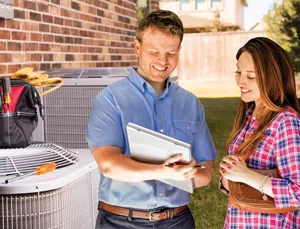Each service call is an opportunity for your technician to review the performance and condition of the entire system.
Service calls are the lifeblood of any home services contracting business. They generate the highest gross margins of practically any product or service offered.
It’s sad, however, how far behind the times our industry is when it comes to servicing our customers to the highest possible level.
For HVACR contractors, each service call is an opportunity to review the performance and condition of the entire system, including supply and return ductwork, filtration, insulation, humidity levels, etc.
The reason for resistance to offer options among technicians is that they don’t want to be perceived as a salesman. The common response they (emphatically) give is: “I am not a salesman!”
Diagnose & Recommend
Customers expect technicians to be able to repair their system, and are pleasantly surprised when they are professional, well-spoken communicators. Their outstanding technical skills will seldom be apparent.
During initial interviews and in training sessions with technicians, instead of trying to force sales techniques on them to improve ticket averages, introduce the concept of Diagnose & Recommend.
This is simply a method to remove the fear of sales from their mindset. When you go to a doctor, it’s his or her job to diagnose your health issues and recommend solutions.
If your visit was for a particular condition and they spot another problem area, does he/she hesitate to inform you? No, of course not. They’re obligated to tell you about it and recommend a solution.
When a technician is at a service call and he/she spots ductwork leaks, inadequate return air, poor quality filters or restricted airflow in certain rooms, or an old, worn-out system, it’s their job to diagnose and recommend, regardless of why the initial service call was placed.
That’s it — no selling is necessary!
It is your technician’s obligation to point out anything to the customer that can improve system performance, comfort, air quality, reduced utility costs, etc. Simply diagnose and recommend. Period.
After diagnosing the problem(s) and recommending solutions to the customer, the technician can list his/her findings on the service ticket along with the pricing to resolve the problem. If the customer shows interest in resolving one or all of the recommendations provided, the technician can provide the benefits in comfort and energy savings these corrective measures will provide.
Of course, technicians should be fairly compensated for offering honest and needed upgrades or replacements of existing systems.
Customer Communication
Here’s a common customer objection most technicians will struggle with:
Customer – “I’ve lived here X years and had several service calls and no one else said I needed any of this stuff. Why is it a problem all of the sudden?”
Assuming this is a brand new customer, here’s the response:
Great question, Mrs. Smith, and I’m glad you brought that up. I can’t explain why these obvious problems have been overlooked by previous technicians. Perhaps they never bothered to look, perhaps they were too busy or maybe they simply don’t care to take on the extra work. I really can’t answer that one.
One thing I can tell you, is that these items I’ve pointed out should be a real concern to any technician who understands the dynamics of airflow and refrigeration principles. These conditions are really pretty basic if you simply take the time to look for them.
Many homeowners face these same problems and are never told by their service providers. I find that amazing, but that is no excuse for me not pointing it out to you. If you have concerns over anything I’ve suggested, go on the Internet and search (for ex. “How to size a return grill/duct).
You will see what industry professionals recommend and why it’s so important to the performance of your system.
I just need your approval right here, and please let me know if you have any questions.
By suggesting that the customer check it out for themselves will many times remove the customer’s concern because the technician is clear, confident and transparent in their offering.
Ongoing Education
This concept is not something you simply toss out once in a weekly training session. To achieve long-term success after you have initially inducted your staff, it has to become a regular discussion in all future meetings. Encourage technicians to discuss successes they’ve had or objections they need help resolving.
For example, a technician may point out that they don’t always have the time and are often rushed by the dispatcher because there is a backlog of calls that are scheduled for that day.
This can be resolved by having your technical staff agree upon and build their own list of common problems in your area that can be quickly diagnosed and easily be pointed out to the homeowner.
These may include:
• An outdoor condenser that is ground level in the dirt and is deteriorating prematurely due to moisture, requiring an elevated pad
• Poorly fitted or poor quality filters
• A dirty or matted cooling coil
• Inadequately sized return grills
• Improperly sized overhead return ducts
• Ask if any rooms lack airflow and recommend an additional or resized duct
• An existing system that is undersized for the home
• Look for applications where a ductless system can resolve comfort issues in certain areas of the home
This list, of course, is customized to include the common problems in your market. Make sure the technicians are responsible for formulating the list to ensure the buy-in on their part is complete. Make a copy of the final list and give each technician a copy to post in his or her vehicle.
Also, decide which of these recommendations will be resolved on the spot or scheduled by the dispatcher for another time with an installer or junior technician.
If you really want to ensure total success with the Diagnose & Recommend program, make it a part of your Technician Debriefing Program.
The debriefing program is another wildly successful way to ensure 100 percent compliance with the field procedures required of your technical staff each day. For many years, Ron Smith’s Technician Debriefing Program has helped contractors across the country improve their service revenue and replacement leads up to 200 percent.
Once the concept of Diagnose & Recommend sinks in, your technicians can perform wonders for your customers, themselves and your company.





